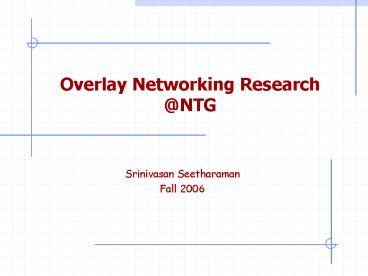Overlay Networking Research NTG - PowerPoint PPT Presentation
1 / 11
Title:
Overlay Networking Research NTG
Description:
Each Overlay path is comprised of one or more Overlay links, inline with a certain objective ... Creating improved service-based architectures and end-system ... – PowerPoint PPT presentation
Number of Views:44
Avg rating:3.0/5.0
Title: Overlay Networking Research NTG
1
Overlay Networking Research_at_NTG
- Srinivasan Seetharaman
- Fall 2006
2
Overlay Networks
- Overlay networks help overcome functionality
limitations of the Internet by forming a virtual
network on top of the IP network. - Overlay nodes collaborate to offer multiple
services - Multicast (Ex ESM, Overcast)
- Alternate paths (Ex RON, Detour, X-Bone,
Brocade) - Customized forwarding (Ex I3, Scattercast)
- QoS (Ex OverQoS, SON)
- Name resolution, Intelligent routing
3
Overlay Networks (contd.)
- Typical features
- Overlay routing is independent of IP layer
routing(Possibly with functionality overlap) - End-system overlays (Ex Skype), or Service
overlays (Offer services to actual end-systems) - Each Overlay link is actually an IP route between
the two overlay nodes - Each Overlay path is comprised of one or more
Overlay links, inline with a certain objective
4
Example Latency-Optimized paths
A
50ms
D
20ms
20ms
C
B
Relaying
- Potential for selfish behavior. Impact varies
based on the - percentage of overlay traffic
- scale of overlay networks
5
What can go wrong?
- Overlay routes can violatenative layer polices-
Srini ICNP06 - Extra load on native linkscausing bottleneck
issues.Serious issue when nativelayer wants
load balance.- Srini Ongoing - Failure detected by both layers and rerouted
twice,with each rerouting disrupting the
optimality of the previous.- Srini Infocom06
6
What can go wrong? (contd.)
- Sub-optimal performance becauseof lack of
cooperation. Potentiallya chicken-and-egg
problem- Srini Hotnets05 - Topology (NodesLinks)placement is tricky-
Jinliang Infocom06, Sridhar Ongoing, YongZhu
Infocom06 - Overlay routing can clash with TCP congestion
control- Ruomei Ongoing
7
1. BGP Policy Violations
- Example violation over Planetlab and its benefit
- 6.3ms lower latency 10.48 gain
- Transit policy is violated in the above example.
Harvard Univ pays its provider unnecessarily and
unavoidably.
8
3. Dual Rerouting
G
2
3
- Consider a native link failure in CE
- Only overlay link AE is affected.
- The native path AE is rerouted over F (ACE ?
ACFDE)
A
I
3
2
4
E
OVERLAY
NATIVE
G
B
I
A
8
F
C
H
Cost
Overlay recovery 8
D
E
Original 2
Native Rerouting 2
Overlay rerouting 4
Time
Native Failure
Native Recovery
Native Repair
9
4. ESM-Friendly Native Network
- Reduce extra copies on some links
- No extra copies on each link
- Latency to reach C is less If there were
native layer support
A
D
New packet replication capability
Similar in spirit to REUNITE, Packet reflection
C
B
10
What can go right?
- 0. The services listed earlier, viz. QoS,
Multicast, resilience, intelligent routing,
security - Improve performance of TCP using schemes like
Overlay-TCP- Pradnya Networking05 - Improve services offered at the native layer by
deploying them at the overlay layer (Ex Name
resolution)- Sridhar Ongoing - Creating improved service-based architectures and
end-system driven functionalities- Anyone
interested?
11
References
- Jinliang Fan, Mostafa Ammar, "Dynamic
Reconfiguration of Service Overlay Networks,"
IEEE INFOCOM, 2006. PDF - Yong Zhu and M. Ammar, "Algorithms for assigning
substrate network. resources to virtual network
components," IEEE INFOCOM, 2006. PDF - Pradnya Karbhari, M.Ammar, E. Zegura, "Optimizing
End-to-End Throughput for Data Transfers on an
Overlay-TCP Path", IFIP Networking, 2005. PS - S. Seetharaman and M. Ammar, "Characterizing and
Mitigating Inter-domain Policy Violations in
Overlay Routes," IEEE ICNP, 2006. PDF - S. Seetharaman and M. Ammar, "On the Interaction
between Dynamic Routing in the Overlay and Native
Layers," IEEE INFOCOM, 2006. PDF - S. Seetharaman and M. Ammar, "Overlay-Friendly
Native Network A Contradiction in Terms?," ACM
HOTNETS IV, 2005. PDF































